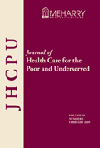 Tom Martin, author of the ACU Column Assessing mHealth Opportunities and Barriers to Patient Engagement [PDF] published in the August 2012 Journal of Health Care for the Poor and Underserved, offered his thoughts on the use of mobile healthcare (mHealth) technologies in caring for the underserved. Martin is a manager at mHIMSS and a doctoral student in public policy at the University of Delaware.
Tom Martin, author of the ACU Column Assessing mHealth Opportunities and Barriers to Patient Engagement [PDF] published in the August 2012 Journal of Health Care for the Poor and Underserved, offered his thoughts on the use of mobile healthcare (mHealth) technologies in caring for the underserved. Martin is a manager at mHIMSS and a doctoral student in public policy at the University of Delaware.
Q. In the article, you say that text messaging is a popular example of mhealth technology. Can you give some examples of health conditions for which text messaging has been tried and what the outcomes were?
A. Text messaging is traditionally used in chronic disease management and for reminders. Text messaging has helped with increased medication adherence, vaccine follow up, and management of chronic illnesses like diabetes. However, phones have advanced significantly and this mode of interaction, while robust and well documented, is falling behind the technology curve. Text messaging may not be useful to individuals with low literacy levels and future initiatives should consider how videos and speech to text platforms like Siri could assist a broader audience.
Q. What about the “digital divide” — do underserved patients have the same access to mobile technology as populations that are more affluent?
A. Pew research and many other organizations are evaluating the demography of mobile usage. Recent research has shown that underserved communities often leverage a mobile device as the sole source of communication and access to the Internet. In developing countries, mobile phones and smart phones have leapfrogged other platforms like computers and laptops. While the penetration rate of technology will never be 100%, there is sufficient evidence to support using the mobile phone and smart phone as a major platform for engagement across all populations.
Q. Does the use of mobile technology raise any particular privacy concerns compared to conventional technologies?
A. There is this notion that our paper documents were somehow more secure than electronic documents. As a former hospital file clerk back in the day, this is not true. Now there is certainly a higher risk of large-scale “data breaches.” However, the public trust in healthcare institutions remains high. Certain policies have complicated our approach to mHealth and the advancement of technologies because certain laws were not designed for a non-paper world. Increasingly end users are aware of what is going on in the background with computers and mobile phones. Privacy and security should complement technology advances and protect an individual’s critical information.
Q. When you look to the future, what do you see in terms of mhealth adoption?
A. I think app-to-app communication is the next progression. There is a huge need in the mHealth industry for standards and interoperability between various platforms. Technology in healthcare has traditionally existed in silos where one instrument only served one purpose. Because of the dynamic nature of mobile device development, many devices will need to interact with each other in a more integrated IT architecture. There are many neat accessory devices for mobile phones in development. The mHIMSS mHealth and Health Disparities Workgroup is beginning to assess the impacts of both apps and accessories for providers in underserved communities. We will have a report available on mHIMSS.org in the future to assist providers working in disparate communities to make informed technology decisions.
 Follow
Follow




Follow Us!